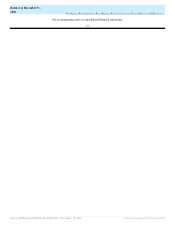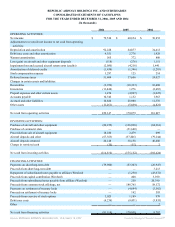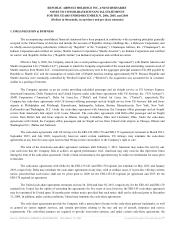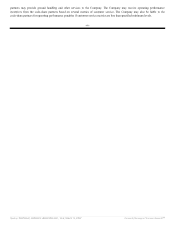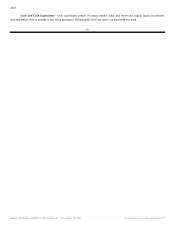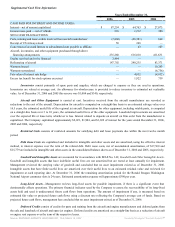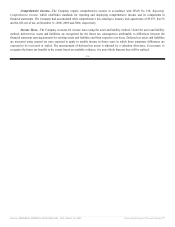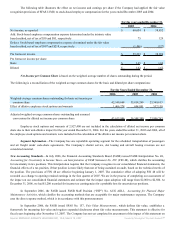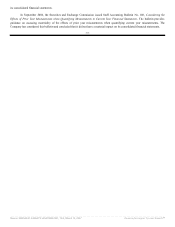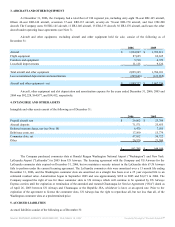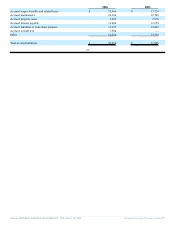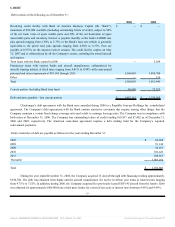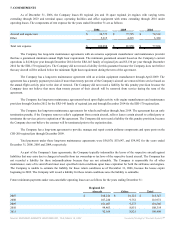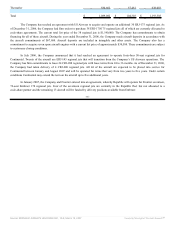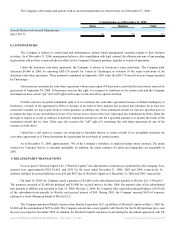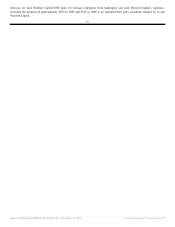Frontier Airlines 2006 Annual Report Download - page 92
Download and view the complete annual report
Please find page 92 of the 2006 Frontier Airlines annual report below. You can navigate through the pages in the report by either clicking on the pages listed below, or by using the keyword search tool below to find specific information within the annual report.
Aircraft Maintenance and Repair is charged to expense as incurred under the direct expense method. Engines and certain
airframe component overhaul and repair costs are subject to power-by-the-hour contracts with external vendors and are accrued as the
aircraft are flown.
Use of Estimates—The preparation of financial statements in conformity with accounting principles generally accepted in the
United States of America requires management to make estimates and assumptions that affect the reported amounts of assets and
liabilities and disclosure of contingent assets and liabilities at the date of the financial statements and the reported amounts of revenues
and expenses during the reporting periods. Under the code-share agreements, the Company estimates operating costs for certain “pass
through” costs and records revenue based on these estimates. Actual results could differ from those estimates.
Revenue Recognition—Passenger revenues, charter revenues and ground handling revenues are recognized in the period the
services are provided. Under our fixed-fee arrangements with American, Delta, US Airways, United, Continental and Frontier, the
Company receives a fixed-fee, as well as reimbursement of specified costs on a gross basis with additional possible incentives from
our partners for superior service. Passenger revenues are recognized in the period the service is provided, and we perform an estimate
of the profit component based upon the information available at the end of the accounting period. The reimbursement of specified
costs, known as “pass-through costs”, may include aircraft ownership cost, passenger liability and hull insurance, aircraft property
taxes, fuel, landing fees and catering. All revenue recognized under these contracts is presented at the gross amount billed for
reimbursement pursuant to Emerging Issues Tax Force Issue (“EITF”) No. 99-19 Reporting Revenue Gross as a Principal versus Net
as an Agent.
Under the Company’s code-share agreements, the Company is reimbursed an amount per aircraft designed to compensate the
Company for certain aircraft ownership costs. In accordance with EITF No. 01-08, Determining Whether an Arrangement Contains a
Lease, the Company has concluded that a component of its revenue under the agreement discussed above is rental income, inasmuch
as the agreement identifies the “right of use” of a specific type and number of aircraft over a stated period of time. The amount
deemed to be rental income during fiscal 2006, 2005 and 2004 was $258,600, $189,800 and $128,600, respectively, and has been
included in passenger revenue on the Company’s consolidated statements of income.
The Company recognizes lease revenue for sub-leases for five ERJ-145 aircraft leased to an airline in Mexico under
operating leases which expire in 2013 and 2015. In addition, the Company recognizes license revenue from US Airways for commuter
slots that were purchased by the Company in 2005 and were utilized by US Airways through 2006 for the New-York LaGuardia
commuter slots, and through 2016 for the Ronald Reagan Washington National commuter slots. Revenues from sub-leases and the
commuter slots are recognized when earned and included in other operating revenue.
Warrants—Warrants issued to non-employees and code-share partners are accounted for under SFAS No. 123(R),
Share-Based Payment, and EITF 96-18, Accounting for Equity Instruments That Are Issued to Other Than Employees for Acquiring,
or in Conjunction with Selling, Goods or Services, at fair value on the measurement date as deferred charges and credits to
stockholders’ equity. Warrants surrendered in a non-monetary transaction are recorded at fair value on the measurement date as
reductions to deferred warrant charges and stockholders’ equity. The deferred charges for warrants are amortized as a reduction of
passenger revenue over the terms of the code-share agreements.
Stock Compensation—The Company maintains stock-based compensation plans which allow for the issuance of
nonqualified stock options to officers, other key employees of the Company, and to members of the Board of Directors. Prior to 2006,
the Company accounted for the stock option plans under the provisions of Accounting Principles Board Opinion No. 25, Accounting
for Stock Issued to Employees, and related Interpretations, whereby, stock options granted that had an exercise price below the market
value were recorded as stock compensation expense. Effective January 1, 2006, the Company adopted the fair value recognition
provisions of SFAS No. 123(R), Share-Based Payment (SFAS No. 123(R)). This statement applies to all awards granted after the
effective date and to modifications, repurchases or cancellations of existing awards. Additionally, under the modified prospective
method of adoption, the Company recognizes compensation expense for the portion of outstanding awards on the adoption date for
which the requisite service period has not yet been rendered based on the grant-date fair value of those awards calculated under SFAS
No. 123(R). SFAS No. 123(R) also requires that forfeitures be estimated over the vesting period of an award, rather than being
recognized as a reduction of compensation expense when the forfeiture actually occurs.
-52-
Source: REPUBLIC AIRWAYS HOLDINGS INC, 10-K, March 15, 2007 Powered by Morningstar® Document Research℠



